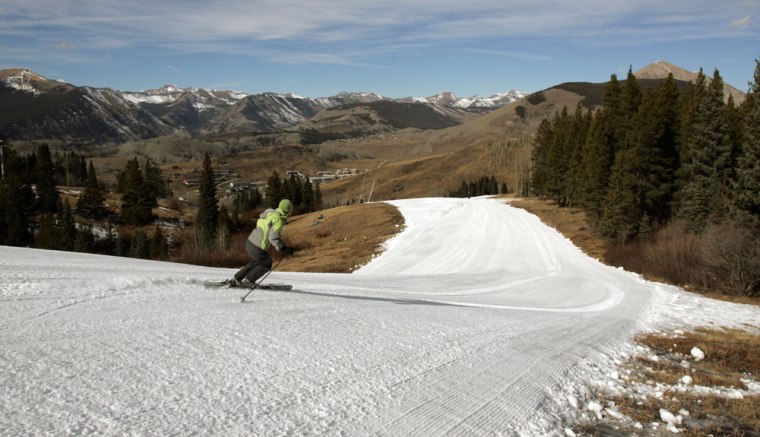Balmy and dry fall weather could put the Colorado ski industry's two-year string of record snowrider numbers in danger, and most of the West isn't in any better shape.
Last year, despite getting less snow than the season before, Colorado numbers were still up 6.7 percent in the first half of the season.
But this year it is even warmer and some major resorts weren't open for Thanksgiving (Nov. 22), usually the first big revenue producer of the season. Telluride and Steamboat still aren't open. Money spent on snowmaking has made it possible for some resorts to open, but if they use the water now they might not have it if they need it later in the year.
Veteran skiers will bring out their rock skis.
During Thanksgiving week, after four straight weeks of temperatures in the 50s F and 60s F (10 C-15 C and 16-21 C), Telluride got 11 inches (28 centimeters), the Telluride Daily Planet reported. "This is a great kickoff to the season. With Mother Nature helping out and the extensive mountain improvements, we're looking forward to a great year," said Telluride CEO Dave Riley. However, the resort will not open until Nov. 30.
Also unlike last year, some of the state's biggest competitors have plenty of snow. Whistler-Blackcomb, which contends with Vail frequently for the No. 1 rank of ski magazines, has 37 inches (94 centimeters). Vail has 18 inches (46 centimeters). Stowe, in Vermont, has 49 inches (125 centimeters) on its upper mountain.
"... for the best and earliest snowfall of the season, head north to Whistler-Blackcomb in British Columbia," says Outside Online.
"We've had lots of early snowfall, 110 centimeters (44 inches). It has been great up here. Sunny but cold so the snow stayed and it is light and fluffy," said Ryan Proctor, public relations coordinator Whistler-Blackcomb. Thirteen lifts are open.
Two exceptions in the Rockies were Big Sky in Montana and Grand Targhee near Jackson, Wyoming.
"We got pasted with a perfect storm early in Thanksgiving week, followed by days of ideal snowmaking temperatures for the lower mountain," said sales and marketing director, Meg O'Leary. "Black diamond powder skiing in November, what else can go right."
Big Sky opened Nov. 23 with the second-most skiable acreage in the Rockies with 854 acres (346 hectares) of advanced, expert, intermediate and beginner terrain. Only Grand Targhee down the road to the south has more terrain open in the Rocky Mountain range from New Mexico to Montana, said O'Leary.
Eldora, one of Colorado's smaller resorts, has the deepest base in the state, 24 inches (61 centimeters).
Wolf Creek, which often has the most snow in the state, has 10 inches (25.4 centimeters), and most of that came Thanksgiving week.
Utah and California resorts also have little snow.
Joan Christensen, industry expert, said some people have already made reservations and will come anyway. "Next year they will punish the industry," she said.
Resorts initially had some trouble making snow until temperatures cooled down to the mid-20s F (7 below zero C) for extended periods. Ski resorts in Colorado have banded together to try to fight climate change.
Meanwhile, resorts in several other areas of North America, hurt by a lack of early snow last year, are doing much better this year.
The long-range forecast for much of the Rockies is for dry weather, possibly leading to drought in some areas next year. The Pacific Northwest, home to Whistler, is expected to be wetter than normal.
The dry weather puts extra pressure on Colorado's resorts because they have sold hundreds of thousands of ski passes. That can bring high numbers of visitors that quickly overwhelm the terrain and lifts that are open.
